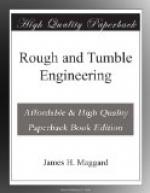The third thing for you to learn, is to keep your eyes on the front wheels of your engine, and not be looking back to see if your load in coming.
In making a difficult turn you will find it very much to your advantage to go slow, as it gives you much better control of your front wheels, and it is not a bad plan for a beginner to continue to go slow till he has perfect confidence in his ability to handle the steer wheel as it may keep you out of some bad scrapes.
How about getting into a hole? Well, you are not interested half as much in knowing how to get into a hole as You are in knowing how to get out. An engineer never shows the stuff he is made of to such good advantage as when he gets into a hole; and he is sure to get there, for one of the traits of a traction engine is its natural ability to find a soft place in the ground.
Head work will get you out of a bad place quicker than all the steam you can get in your boiler. Never allow the drivers to turn without doing some good. If you are in a hole, and you are able to turn your wheels, you are not stuck; but don’t allow your wheels to slip, it only lets you in deeper. If your wheels can’t get a footing, you want to give them something to hold to. Most smart engineers will tell you that the best thing is a heavy chain. That is true. So are gold dollars the best things to buy bread with, but you have not always got the gold dollars, neither have you always got the chain. Old hay or straw is a good thing; old rails or timber of any kind. The engineer with a head spends more time trying to give his wheels a hold than he does trying to pull out, while the one without a head spends more time trying to pull out than he does trying to secure a footing, and the result is, that the first fellow generally gets out the first attempt, while the other fellow is lucky if he gets out the first half day.
If you have one wheel perfectly secure, don’t spoil it by starting your engine till you have the other just as secure.
If you get into a place where your engine is unable to turn its wheels, then your are stuck, and the only thing for you to do is to lighten your load or dig out. But under all circumstances your engine should be given the benefit of your judgment.
All traction engines to be practical must of a necessity, be reversible. To accomplish this, the link with the double eccentric is the one most generally used, although various other devices are used with more or less success. As they all accomplish the same purpose it is not necessary for us to discuss the merits or demerits of either.
The main object is to enable the operator to run his engine either backward or forward at will, but the link is also a great cause of economy, as it enables the engineer to use the steam more or less expansively, as he may use more or less power, and, especially is this true, while the engine is on the road, as the power required may vary in going a short distance, anywhere from nothing in going down hill, to the full power of your engine in going up.




